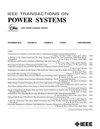估算配电网络中电力流方程的吸引力盆地
IF 6.5
1区 工程技术
Q1 ENGINEERING, ELECTRICAL & ELECTRONIC
引用次数: 0
摘要
这封信提出了配电网络中功率流吸引盆地的内外部估算方法。所提出的方法可用于定义功率流算法的收敛区域,并在不明确求解功率流方程的情况下估计电网的最小和最大电压。在三相不平衡 IEEE 906 节点测试系统中进行的数值实验显示了所提方法的用途。结果包括收敛性分析以及考虑了 1440 种不同负载和可再生能源发电情况的准动态模拟。本文章由计算机程序翻译,如有差异,请以英文原文为准。
Estimating the Basin of Attraction for the Power Flow Equations in Power Distribution Networks
This letter presents an inner and outer estimation for the basin of attraction of the power flow in power distribution networks. The proposed methodology can be used to define the convergence region of the power flow algorithm and to estimate the minimum and maximum voltage of the grid without explicitly solving the power flow equations. Numerical experiments in the three-phase unbalanced IEEE 906 nodes test system show the use of the proposed methodology. Results include convergence analysis as well as a quasi-dynamic simulation considering 1440 different scenarios of load and renewable power generation.
求助全文
通过发布文献求助,成功后即可免费获取论文全文。
去求助
来源期刊

IEEE Transactions on Power Systems
工程技术-工程:电子与电气
CiteScore
15.80
自引率
7.60%
发文量
696
审稿时长
3 months
期刊介绍:
The scope of IEEE Transactions on Power Systems covers the education, analysis, operation, planning, and economics of electric generation, transmission, and distribution systems for general industrial, commercial, public, and domestic consumption, including the interaction with multi-energy carriers. The focus of this transactions is the power system from a systems viewpoint instead of components of the system. It has five (5) key areas within its scope with several technical topics within each area. These areas are: (1) Power Engineering Education, (2) Power System Analysis, Computing, and Economics, (3) Power System Dynamic Performance, (4) Power System Operations, and (5) Power System Planning and Implementation.
 求助内容:
求助内容: 应助结果提醒方式:
应助结果提醒方式:


